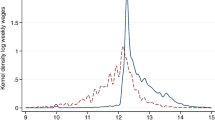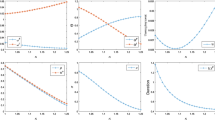Abstract
Kyrkopoulou and Palivos examine the interaction between the informal sector of the economy and undocumented immigration. For this purpose, they use a search and matching model with two sectors, a formal and an informal one. Native workers can work in both sectors, whereas undocumented immigrants can work only in the latter. Both native workers and firms choose optimally the sector in which they operate, balancing costs and benefits, for example, taxation versus unemployment benefits and severance payments in the case of workers and taxation and auditing versus subsidies in the case of firms. The effects of three types of policies are analyzed and compared: deterrence, incentive, and immigration policies. Combinations of these are also considered.
Access this chapter
Tax calculation will be finalised at checkout
Purchases are for personal use only
Similar content being viewed by others
Notes
- 1.
Schneider et al. (2010) finds that the average size of the informal sector in southern Europe countries, during the period 1999–2007, was 25% of official GDP.
- 2.
- 3.
We abstract from legal immigration. Alternatively, one can assume that legal immigrants are lumped together with natives.
- 4.
In this model, there are no quits and every termination of employment is a no-fault dismissal.
- 5.
We assume that η is the penalty rate net of any administrative cost that is necessary to enforce the law.
- 6.
Battisti et al. (2018) cite empirical evidence in support of this assumption.
- 7.
We assume that wages are constantly renegotiated at no cost. Hence, the relevant wage for an unemployed worker who contacts a firm in the formal sector for the first time, and hence is not entitled to a severance payment, is the same wage as the one for an already employed worker. This is so, because the unemployed worker will immediately renegotiate the wage once a contract is signed.
- 8.
All proofs are presented in an Appendix available upon request.
- 9.
- 10.
We present below some representative cases; details are available upon request.
References
Battisti, M., G. Felbermayr, G. Peri, and P. Poutvaara (2018). “Immigration, Search, and Redistribution: A Quantitative Assessment of Native Welfare”, Journal of the European Economic Association, 16(4), pp. 1137–1188.
Blanchard, O., and P. Diamond (1989). “The Aggregate Matching Function”, NBER Working Paper No. 3175.
Boeri, T., and Garibaldi, P., (2005, September). Shadow sorting. In NBER International Seminar on Macroeconomics (pp. 125–163). University of Chicago Press.
Borjas G., Friedman R., and Katz L. (1997). “How Much Do Immigration and Trade Affect Labor Market Outcomes”, Brookings Papers of Economic Activity 28(1), pp. 1–90.
Bosh M. and Pretel J., (2012). “Job Creation and Job Destruction in the Presence of Informal Markets”, Journal of Development Economics 98, pp. 270–286.
Card D., (1990). “The Impact of the Mariel Boatlift on the Miami Labor Market”, Industrial and Labor Relations Review 43(2), pp. 245–257.
Chassamboulli, A., and T. Palivos (2013). “The Impact of Immigration on the Employment and Wages of Native Workers.” Journal of Macroeconomics, 38(Part A), pp. 19–34.
Chassamboulli, A., and T. Palivos (2014). “A Search-Equilibrium Approach to the Effects of Immigration on Labor Market Outcomes.” International Economic Review, 55(1), pp. 111–29.
Cuff K., Marceau N., Mongrain S., and Roberts J., (2011). “Optimal Policies with an Informal Sector”, Journal of Public Economics 95, pp. 1280–1291.
Di Porto E., Elia L. and Tealdi C., (2017). “Informal work in a flexible labour market”, Oxford Economic Papers, 69(1), 1 January 2017, pp. 143–164.
Di Porto, E., Persico, N., & Sahuguet, N. (2013). “Decentralized Deterrence, with an Application to Labor Tax Auditing”, American Economic Journal: Microeconomics, 5(1), pp. 35–62.
Fugazza M., and Jacques J., (2004). “Labor Market Institutions, Taxation and the Underground Economy,” Journal of Public Economics 88(1–2), pp. 395–418.
Hazans, M., (2011). “Informal Workers Across Europe: Evidence from 30 Countries”. IZA Discussion Paper, No. 5871.
Liu, X., T. Palivos and X. Zhang (2017). “Immigration, skill heterogeneity, and qualification mismatch, Economic Inquiry, 55(3), pp. 1231–1264.
Mortensen, D. T., and C. A. Pissarides (1994). “Job Creation and Job Destruction in the Theory of Unemployment.” Review of Economic Studies, 61(3), pp. 397–415.
Mortensen, D. T., and C. A. Pissarides (1999). “New developments in models of search in the labor market” in O. Ashenfelter and D. Card (Eds.) Handbook of Labor Economics, Amsterdam. North Holland.
Ortega, J. (2000). “Pareto-Improving Immigration in an Economy with Equilibrium Unemployment,” Economic Journal 110(460), pp. 92–112.
Ottaviano, G. I. P. and Peri G., (2012). “Rethinking The Effect Of Immigration On Wages,” Journal of the European Economic Association, 10(1), pp. 152–197.
Pappa, E., R. Sadeji, and E. Vella, E. (2015). “Fiscal Consolidation with Tax Evasion and Rent Seeking,” Journal of International Economics, 96, pp. S56-S75.
Petrongolo, B., and Pissarides, C. A. (2001). “Looking into the Black Box: A Survey of the Matching Function.” Journal of Economic Literature, 39(2): pp. 390–431.
Shimer, R., (2005). “The Cyclical Behavior of Equilibrium Unemployment and Vacancies,” American Economic Review 95(1), pp. 25–49.
Schneider F., Buehn A. and Montenegro C., (2010), “New Estimates for the Shadow Economies all over the World”, International Economic Journal, 24 (4), pp. 443–461.
Schneider, F. G. and C. C. Williams (2013). The Shadow Economy. Institute of Economic Affairs.
Zenou, Y. (2008). “Job Search and Mobility in Developing Countries: Theory and Policy Implications,” Journal of Development Economics 86(2), pp. 336–355.
Author information
Authors and Affiliations
Corresponding author
Editor information
Editors and Affiliations
Rights and permissions
Copyright information
© 2020 The Author(s)
About this chapter
Cite this chapter
Kyrkopoulou, E., Palivos, T. (2020). Doing Business in the Shadows: Informal Firms, Irregular Immigrants and the Government. In: Vella, E., Caballé, J., Llull, J. (eds) Understanding Migration with Macroeconomics. Palgrave Macmillan, Cham. https://doi.org/10.1007/978-3-030-40981-4_6
Download citation
DOI: https://doi.org/10.1007/978-3-030-40981-4_6
Published:
Publisher Name: Palgrave Macmillan, Cham
Print ISBN: 978-3-030-40980-7
Online ISBN: 978-3-030-40981-4
eBook Packages: Economics and FinanceEconomics and Finance (R0)




